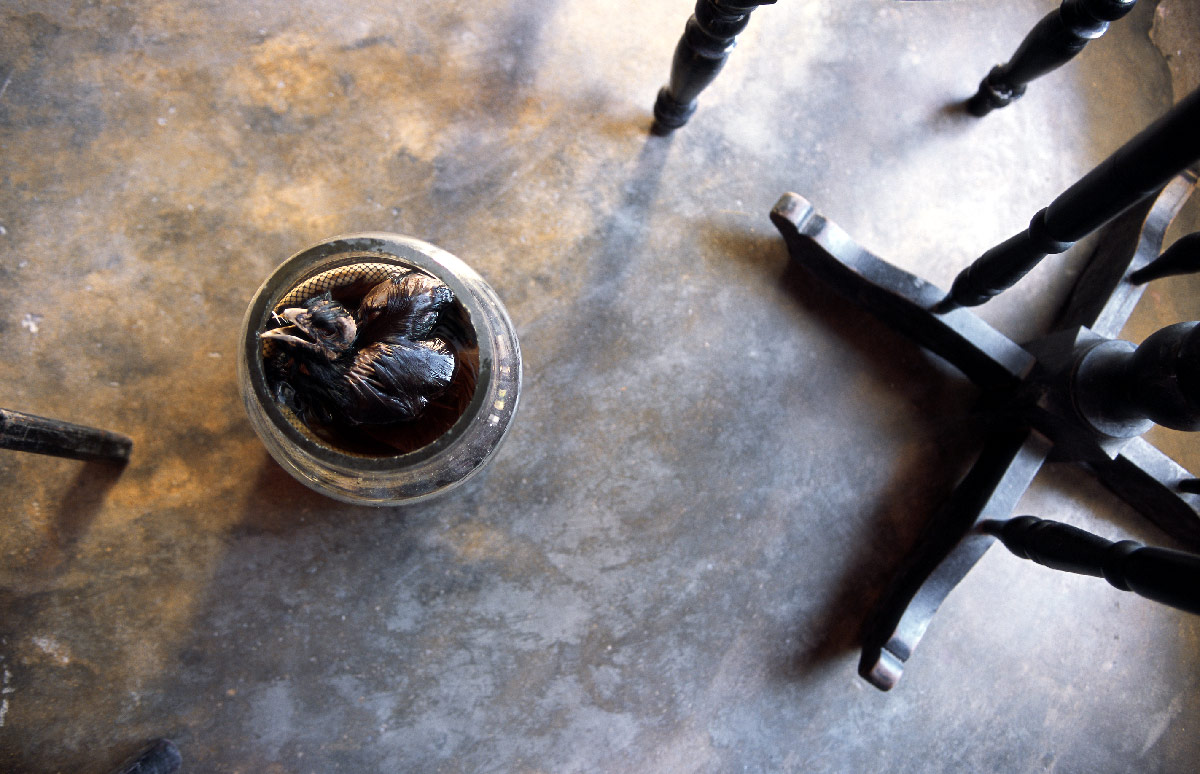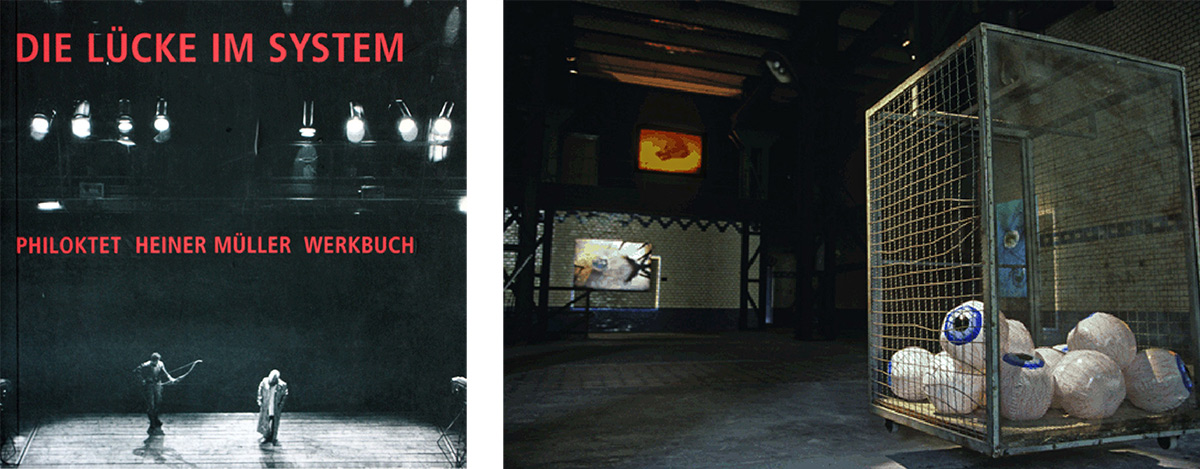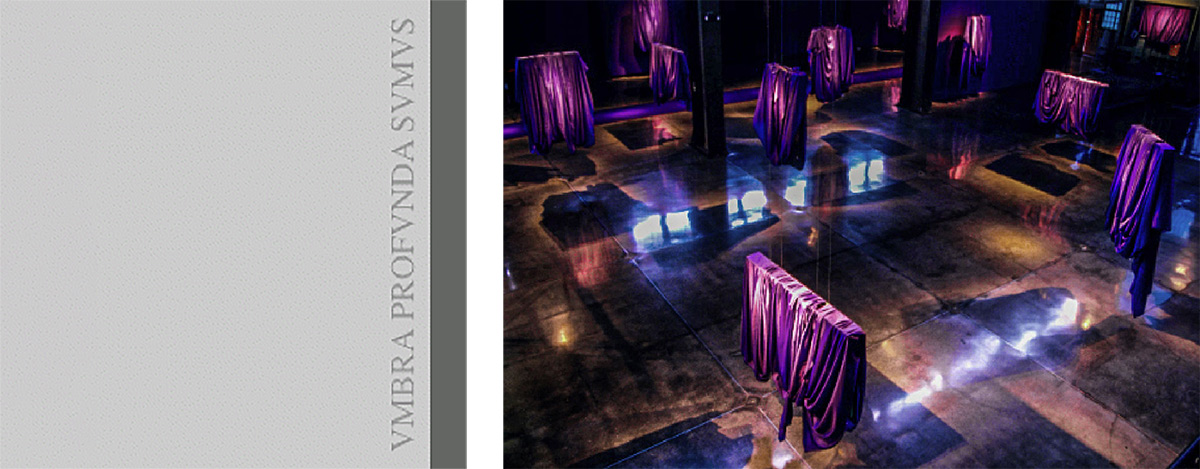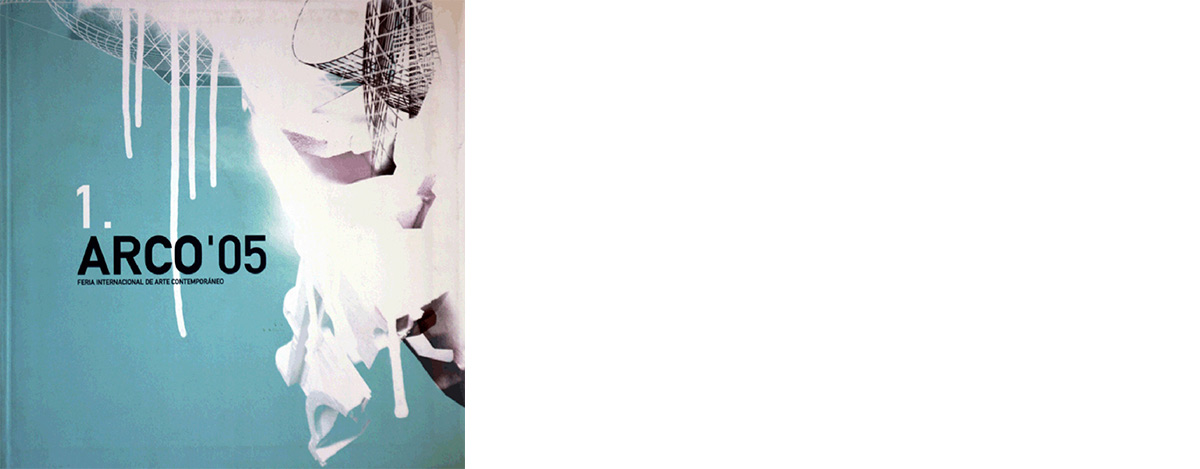VMBRA PROFVNDA SVMVS

“The shadow prepares the sight for light. Through the shadow, the Divine Temples place before the darkened eye of the hungry and thirsty soul, such images that are the messangers of things. Try then to recognize shadows that never extinguish, but preserve and keep in within ourselves the light; throughout which we are guided and reconducted to the intellect and the memory.”
Giordano Bruno, De umbris idearum, 1582
Mutating and adapting to the different exhibition spaces, the installation which started in Berlin, at the Berliner Festspiele, has been presented in several other cities, such as Rome, Monterrey and Mexico City.
The title for the series of photographs and installations comes from the words of Giordano Bruno The Nolan:
“Vmbra profvnda svmvs” (Deep Shadows We Are), taken from his hermetic text “Shadows of the Ideas”.
Museums & Galleries
Tödliches Spiel: das Leben
Bewag Halle-Prenzlauerberg (Berliner Festspiele)
Curators: Wolfgang Storch & Klaudia Ruschkowski
Berlin, 2004
.

There are no titles, only indications of the place and year of the photograph: Saigon 2002, Tehran 2004, Naples 2003. The photographic eye of Alejandro Gómez de Tuddo captures traces of an almost archaic, daily, and universal violence: bodies of animals reduced to shreds, slaughtered or sacrificed in rituals that survive into our postmodern times; living creatures that other living creatures kill for nourishment or simply to ingratiate themselves; beings that only exist in the imaginary.
This is what these photographs force us to see: the brutal evidence of life being violated, the violence of men and their culture. The photographic glance of Alejandro Gómez de Tuddo presents us crude but elegant images, with an almost obscene elegance which causes a profound discomfort, because it forces us to endure the scandalous fascination of beauty arising from horror. It makes our very skin feel the scandal of art transforming into poetry, the crude reality of death, suffered or inflicted; the cruel game of life devouring itself. However, without disturbing us, this scandalous art makes us think and feel, with an almost unbearable intensity of the horror of this world, by displaying it and at the same time concealing it, hidden within a beauty which connects us intimately with it, because it deactivates our usual removal mechanisms, exposing us to the senseless cruelty of human culture and allowing us to perceive in it —in ourselves— something transcending it: the irreducible desire of another state of the world, perennially speaking through beauty; in a need for beauty that never stops, not even before the most terrible manifestations of life being perturbed by irreparable, unredeemable violence.
Gómez de Tuddo’s work never allows violence the last word; he knows how to remove something that in a certain way redeems it, without erasing the terribleness; something that, together with an anguishing and crushing sadness, is occasionally capable of transmitting an awkward joy. In the case of the playful photograph of a goat hanging from a Palermo market stand, we see it jumping out from a reddish-orange background. It seems as if though the animal were almost flying away from the blood bath in which its life was drowned, as if its life had not been taken away but continues to be, outside itself, beyond itself, in an unattainable somewhere. It is precisely towards such an unreachable place that Alejandro’s photographs lead us to: the nowhere of a life that is no longer life, but which is not, however, non-existent. It exists, but is eternally foreign and still accompanies us always and everywhere, though always and everywhere, distant from us, both from the being and from nothing.
Francesco Fiorentino
Gioco mortale: la vita
Istituto Italo Latinoamericano (IILA)
Gallery: Scuderie del Palazzo Santa Croce
Curator: Irma Arestizábal
Rome, 2005

La morada de la araña
La morada de la araña es la más frágil de las moradas
(CORAN 29, 40)
Como la tela de la araña que evoca una realidad de apariencias ilusorias y engañosas que, al mismo tiempo, seducen a sus víctimas, las bellísimas fotos de Alejandro Gómez de Tuddo esconden una realidad violenta revestida de mórbida sensualidad.
Sus imágenes sorprenden al colocarnos frente la violencia y la muerte, y, a la vez, frente a la persistencia de la existencia.
En general son detalles “descubiertos” por un ojo atento[1] que captura como una “red visual” y muestra: extrañas combinaciones formales – círculo, vacío y, siempre, las diagonales – crean una geometría muy particular que rige la composición de todas las escenas. Colores fuertes, saturados – naranjas, negros, rojos, verdes y blancos- que se potencian en el contraste y que Gomez de Tuddo combina “ton sur ton” tono sobre falso tono, de manera que cada vez sentimos la intensidad extrema de la variación.
Una estética que retoma del manierismo el poder de sobre- individualización, haciendo que hasta las imágenes mas comunes, los estilos mas conocidos, puedan engendrar figuras únicas, extrañas y preciosas.
Esa constante de nuestra vida que es la muerte ejerce, desde siempre, una gran atracción sobre el hombre. Esta realidad, exacerbada y constantemente presente en este inicio de siglo teñido de muerte y corrupción, provoca el surgimiento de manifestaciones poéticas que, como las que actualmente nos ocupan, están contaminadas por la vida.
Las fotografías Alejandro Gómez de Tuddo son una forma dolorosa de registro de la presencia de la muerte, que designa el fin absoluto de algo positivo; ser humano, animal, planta, amistad, alianza, paz, época, y, al mismo tiempo, su persistencia en nuestro imaginario. Como cuando, de acuerdo con Rosalind Krauss[2], Barthes se da cuenta de que lo escandaloso de la fotografia es la certeza del “esto-ha-sido” que se pega a la imagen, certeza de que el punctum, (este nuevo punctum que ya no es formal sino de intensidad) es el tiempo”
Alejandro Gómez de Tuddo se cuenta entre los artistas que trabajan la muerte por su vinculación con la vida. Su obra, marcada por una incomoda sensualidad cargada de extraño magnetismo, delata el deseo de detener el tiempo, de impedir, al menos con la imagen fotográfica, el final de la materia que se deshace. Como Damien Hirst, parece decirnos que “La muerte es una idea inaceptable, de modo que la única manera de tratarla es estando distanciado o ironizando”[3]
Gomez de Tuddo llega a esta realidad a través de una combinación altamente estética y tan atrayente como la profundidad del mar, el vacío del abismo o …la morada de la araña.
Irma Arestizábal
[1] “…no manipulo la realidad, me adapto a ella: me muevo hasta encontrar la forma y la luz adecuadas o me sorprendo ante la aparición de la composición imaginada y la registro”. Entrevista de C. Motta, curador de Field of Depth, Latin Collector Gallery, N.,Y., 2004.
[2] Lo fotografico, citado por Oscar Muñoz, El Puente, Cali, noviembre 2004.
[3] Michele S. Cone, “Territorios/ Una entrevista con Damien Hirst”, Atlantica/Internacional/Revista de Artes, Centro Atlantico de Arte Moderno, Gran Canarias, número 7, Primavera 1994.
VMBRA PROFVNDA SVMVS I
Centro de las Artes Monterrey – Fototeca- Parque Fundidora
Curator: Loretto Garza Zambrano
Monterrey, 2005

Gomez de Tuddo is one of the now rare breed of visual artists that rely on the wondrous serendipity of chance encounters. He can’t censor his own discomfort by embellishing the result. But as you gaze, you know you are not being exploited by the intention to nauseate or disgust, to sensationalize by playing on a viewer’s inner guilt. His subject may be the slaughtered, the excreted, the neglected beings, places or things in our everyday world. Through these documents of death and decay, he creates an altar to the mysteries inherent to the cycle of creation and destruction without preferential treatment to either.
This photographic theater invokes respect and pays homage without sentimentalizing its subject matter. It may be exceptionally beautiful at times, but won’t allow an aesthetic that distances and alienates by petrifying its subject in an amber of artificial light and stylized effects. Even though we are forced to look at these images head on (many are large format with the impact of a mural), we don’t feel coerced or confronted by them. To some they may feel like elegies to the careless attitudes of our post-industrial age. To others they may reveal some secret truth about life, death and eternity. He has the eye and talent to bring his work the aesthetic rigor of still life without being precious or contrived.
The images, though, can’t remain static long. They are bathed in saturated colors that sometimes feel primary, but are more chromatic and unstable. You look and are convinced the blue you see belongs to the sky, but Gomez de Tuddo throws narrative into the dynamic that reveals its provenance, a crumbling frescoed wall or the innards of a tunnel. Like all great artists whose work may be instantly accessible and infinitely multilayered, he both seduces with bold imagery and plays a hide-and-seek game with context and meaning. One of his images may seem alive with violence and movement until a blink of the eye fixes it into the stillness
of an icon.
Steven de Sanctis
VMBRA PROFVNDA SVMVS II
Museo de Arte Moderno
Curator: Luis M. Lozano
Mexico City, 2005

Death appears on stage portrayed by an artist who loves Greek tragedy and is inspired by the work of Heiner Müller; surrounded by suggestions and enamel colors – displaying all its terrible fascination.
When death is deprived from its raw appearance and ruthless horror that often comes together, dealing with her shamelessly must be a very difficult task, specially if represented through images of viscera and blood, whose colors are sometimes highlighted with an almost dazzling vivacity.
Alejandro Gómez de Tuddo’s photographs taken around the world disconcert the viewer, creating suggestions that swing between the hardness of the glassy eyes of dead animals to the grace of an ideal esthetic.
On one hand, the idea of decay and death leads to discomfort and anxiety faced with the inevitable; on the other, the artist is able to transform the objects into bodies with new life, while “coating a violent reality with uncomfortable sensuality”, as mentioned by curator Irma Arestizábal in the exhibition’s catalogue.
Antonin Artaud in “Art and Death” approached the “transfer” in carnal terms -also in sexual terms-, linking it to life through a reciprocal generative moment, and after having embarked on a harrowing journey through the darkness of pain, he is able to get closer and writes: All things, even the most cruel ones, manifest themselves only through their balancing aspect, in a perfect indifference of sense.
The artwork exhibited by Gómez de Tuddo seems to follow a similar path; departing from pain it reaches the representation of a fascinating reality, with the stolid acceptance of who has seen and played the “deadly game of life”.Even though he might not seem to talk about definitive disappearance, through the strident contrast that characterizes his animals -pairing them to organs in formaldehyde often found at the forensic theatre- and the poetic beauty of images such as the bleeding heart, adorned with a candid crown of flowers, the artist is searching for a new definition of death, far away from the idea of otherworldly life, because, basically “the issue” is extremely physical.
Federica La Paglia, Exibart, Rome, March 22nd, 2005
ARCO, Arco Latino
Parque Ferial Juan Carlos I
Curator: Alfredo Zaya
Madrid, 2005

“Alejandro Gómez de Tuddo’s work among the top ten most interesting proposals on view at ARCO of the more than six thousand works exhibited.”
“Master of light, color and subject matter, Alejandro Gómez de Tuddo exhibits a series of still-lifes: photographic compositions with a pictorial character, the result of an urban mythology characterized with irony.”
20 minutos, Madrid, February 11, 2005
“ARCO 2005: The work of Alejandro Gómez de Tuddo stands out…an art that can really be appreciated without needing to display its certificate of origin.”
ABC, Madrid, February 12, 2005
“Alejandro Gómez de Tuddo with his involving and elliptical gigantographies. Distressing still-lives (animals or organic materials) that detour from their real iconography to become something else: Birds bound forever in love and death, like awesome violet feathers; a goat’s head in a fuchsia net, hanging from the handle bar of a motorcycle over a pop lemon-yellow background from a street wall of Tehran; a dish full of ruby-like blood cubes. Alejandro Gómez de Tuddo is completely independent from the ethno-representation of his identity, he sets apart his image towards the bowels of a sensitive world without national boundaries.”
Teresa Macrí, Il Manifesto, Rome Februrary 17, 2005
